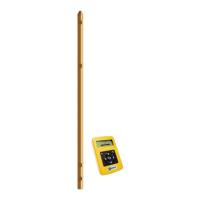MANUAL – REFLEX EZ-TRAC™ | 21
The magnetic dip can vary depending on ones position on the surface
of the Earth. Near the equator it approaches horizontal (0 degrees),
but steeper towards vertical (90 degrees) at the poles.
The general convention is that the magnetic dip is positive
(downwards) in the northern hemisphere and negative (upwards) in
the southern.
6.3.3 Magnetic integrity
Since two types of magnetic data are provided – the total magnetic
field strength and the magnetic dip – it is possible to check if the
magnetic results are plausible.
Both values should remain constant in any given location, with some
natural variation, unless altered by some form of natural or man-made
disturbance.
In order to determine if discrepancies are present, the background
field (magnetic reference) has to be established.
6.3.4 Magnetic declination
The direction in which the compass needle points is referred to as
magnetic north. The angle between magnetic north (horizontal
component of the magnetic field) and true north is called magnetic
declination. It can also be referred to as magnetic variation or
compass variation.
The magnetic declination varies from place to place and with time,
due to the complex fluid motion in the Earth’s core. This causes the
magnetic field to change with time. This change is known as secular
variation.
Note, REFLEX
TM
magnetic instruments measure the azimuth relative to
magnetic north. To obtain the true north, magnetic declination rules
must be applied. As a general rule, you must subtract if the
declination is west and add if the declination is east.
The value for the geomagnetic declination may be obtained from
regional geomagnetic declination and inclination maps or from
geomagnetic reference field models. This magnetic declination value
may be entered in and applied to surveys in
REFLEX™ SProcess.
6.4 Rotation
REFLEX™ magnetic instruments are capable of measuring rotation
relative to both gravity, using the gravity tool face angle, and to
magnetic north, using the magnetic tool face angle.
Rotation relative to gravity is used for inclinations from -85 to +85
degrees. Rotation relative to magnetic north is used for holes that are
within 5 degrees from vertical.
The rotation information is used to determine the orientation of a
downhole object, for example a wedge or a tool.

